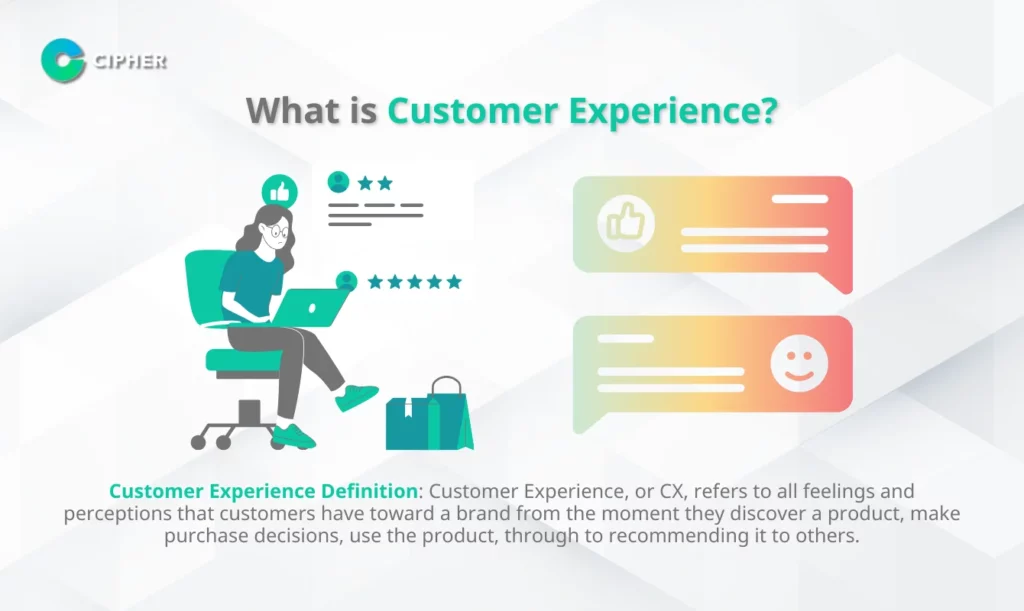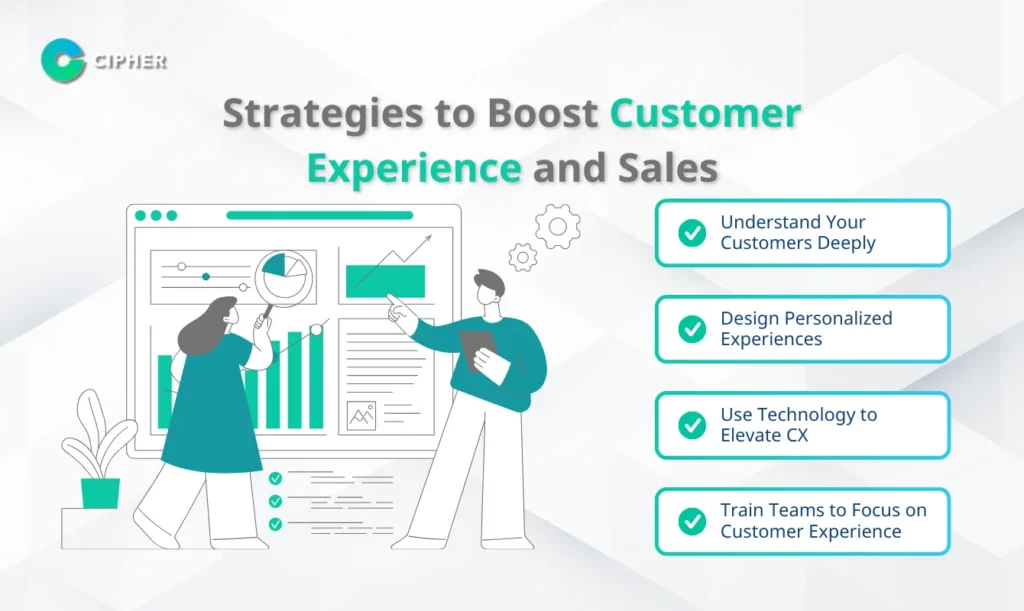Table of Contents
In today’s world where customers have numerous options, businesses that understand and care about customer experiences are winning the race. Developing a Customer Experience strategy is crucial to capturing customers’ hearts and closing sales quickly. At Cipher, we believe CX isn’t just about satisfaction or creating basic customer experiences. In this article, we’ll explore effective methods to boost Customer Experience that truly work in today’s business landscape, along with marketing planning services across various platforms and marketing concepts that respond to rapid changes—enabling you not just to compete but to lead the market with confidence.
What is Customer Experience?

Customer Experience Definition: Customer Experience, or CX, refers to all feelings and perceptions that customers have toward a brand from the moment they discover a product, make purchase decisions, use the product, through to recommending it to others. Customer Experience is the sum of all touchpoints (both online and offline) between customers and a business. Positive experiences can transform regular customers into loyal brand advocates, making the development of Customer Experience a worthwhile investment for businesses of all types. It also benefits the development of CRM systems that organizations use to improve customer relationships.
What Elements Make Up Customer Experiences?
Creating excellent Client Experiences requires managing multiple components systematically. Here are the key elements:
- Various Touchpoints: Every point of contact between customers and your brand—before purchase (information search, advertisements), during purchase (payment, store atmosphere), and after purchase (status tracking, warranty)—creates impressions and affects repurchase decisions.
- Customer Service: The quality and speed of service, problem-solving, and responsiveness to customer needs are at the heart of the Experience Customer relationship—creating differentiation and leaving lasting impressions.
- UI/UX on Websites or Apps: Designing beautiful, user-friendly websites and applications reduces confusion and increases conversion opportunities.
- Response Speed: Promptly addressing customer questions or issues demonstrates care and builds trust in your brand.
- Personalization: Presenting products, services, and communications tailored to individual customer preferences and behaviors makes customers feel special and understood.
Effective management of Consumer Experience requires coordinating these elements cohesively and systematically. When every touchpoint delivers experiences exceeding expectations, customers become impressed, leading to repeat purchases and referrals—key factors in using Customer Experience to boost sales sustainably.
Why is Customer Engagement Important?
Today’s rapidly changing technology has significantly transformed consumer behavior. Modern consumers not only want quality products or services but also expect impressive experiences at every purchasing stage. This makes creating Customer Engagement a crucial factor in business competition.
Recent studies show that customers with high Customer Engagement tend to spend 60% more than average customers and demonstrate greater brand loyalty. Creating engagement through improved Customer Experience effectively boosts sales because today’s customers desire deeper relationships with brands rather than being mere buyers.
Strategies to Boost Customer Experience and Sales

1. Understand Your Customers Deeply
2. Design Personalized Experiences
Creating personalized experiences is key to making impressions and increasing sales opportunities, especially in an era of high customer expectations. Using data to customize experiences for individual customers is essential. Effective methods for personalization include:
- Product recommendations based on past behavior: Analyzing purchase history and product views helps recommend products that precisely match customer interests, increasing click rates and product purchases by up to 35%.
- Personalized messaging: Customizing email content, SMS, or notifications to align with customer interests and behaviors, such as offering birthday discounts or alerts when items of interest have special promotions.
- Smarter chatbot systems: Developing chatbot systems capable of remembering and understanding the context of conversations with each customer helps make conversations natural and quickly addresses customer needs.
3. Use Technology to Elevate CX
4. Train Teams to Focus on Customer Experience
Employees represent your brand when interacting with customers. Training teams to understand and prioritize excellent experience creation is vital for boosting Customer Experience and sales, including:
- Soft Skills Training: Communication skills, listening, showing empathy, and solving immediate problems are fundamental skills for creating positive customer experiences. Employees with good soft skills can turn challenging situations into opportunities to create impressive experiences.
- Customer Communication Techniques: Training in effective communication techniques—such as using positive language, active listening, and clear communication—helps employees build good relationships with customers and understand their true needs.
- CX-related KPI Measurement: Establishing KPIs related to customer experience, such as NPS (Net Promoter Score), CSAT (Customer Satisfaction Score), or CES (Customer Effort Score), and incorporating them into employee performance evaluations helps everyone recognize the importance of creating good customer experiences.
What is Customer Experience Management?
Customer Experience Management (CXM) is the systematic process of managing all customer experiences at every touchpoint. Its objective is to create satisfaction, engagement, and loyalty of customers to the brand. Effective customer experience management requires data collection, analysis, and designing strategies that cover all communication channels and customer touchpoints, ensuring customers receive smooth, consistent experiences that meet expectations. Customer Experience Management is therefore a crucial tool in developing Customer Experience to boost sales.
Examples of Businesses Successfully Using Customer Experience to Increase Sales
Starbucks
Creates coffee shop experiences that go beyond drinking coffee through store atmosphere, friendly service, and applications that help customers order and receive products conveniently:
- Created membership programs with point accumulation systems and rewards that appeal to customers
- Uses mobile applications for Mobile Order & Pay to reduce waiting time and increase convenience
- Adapts store atmospheres suitable for working, socializing, and creating experiences beyond just a coffee shop
Amazon
Focuses on creating convenient, fast, and personalized shopping experiences through accurate product recommendation systems and quick delivery:
- Develops product recommendation systems that learn customer behaviors and preferences
- Creates fast delivery systems and various status tracking features
- Prioritizes easy and convenient return processes to build confidence in ordering
Apple
Presents product usage experiences that are simple yet high-quality, with quality after-sales service through Apple Stores and the Genius Bar:
- Designs stores where customers can fully try products
- Trains employees to have deep knowledge about products and provide useful recommendations
- Creates usage patterns for products that work together seamlessly to create the best user experience
Connecting CX with Marketing Through Customer Experience Marketing
Marketing Customer Experience is the integration of marketing strategies with customer experience creation to attract and retain customers. This concept doesn’t just focus on advertising or sales promotion but also emphasizes creating impressions at every touchpoint to make customers feel good about and connected to the brand.
Connecting Customer Experience with marketing strategies helps businesses create marketing messages consistent with the actual experiences customers receive, increasing credibility and trust in the brand. Developing Customer Experienceto boost sales through Experiential Marketing involves creating activities or campaigns that allow customers to participate and directly experience the brand’s value, making customers remember and become more attached to the brand than receiving one-way messages from typical advertisements.
Customer Experience Services from Cipher's Expert Team
Developing effective customer experiences requires expertise and experience. Cipher’s team is ready to provide comprehensive CX Services to help businesses elevate customer experiences and increase sales effectively, including Social Media Marketing services targeted to specific audiences:
- Customer Journey Analysis and Design: Analyzing customer behaviors and needs to design smooth and impressive product and service purchasing journeys
- Omnichannel CX Strategy: Developing systems and strategies that connect customer experiences across all channels, both online and offline, to provide consistent and seamless experiences
- CRM System Development and Data Analysis: Using technology and data to understand customer behavior and develop targeted experiences
- CX Employee Training: Creating organizational cultures that prioritize customer experiences through necessary training and skill development
- CX Monitoring and Measurement: Tracking and measuring the effectiveness of Customer Experience strategies with appropriate indicators to continuously improve and develop
Summary: Methods to Boost Customer Experience and Double Your Sales
Developing Customer Experience to boost sales isn’t about luck or coincidence but a strategy requiring planning and systematic implementation—from deeply understanding customers, designing personalized experiences, using appropriate technology, to training teams to recognize the importance of customer experiences. Businesses successful in creating good customer experiences share a common characteristic: focusing on creating value and satisfaction for customers at every touchpoint. Developing Customer Experience to boost sales isn’t just about improving some aspects of your business but changing the entire thinking and organizational culture to focus on customers as the center.
Now is the time for your business to elevate customer experiences for dramatic sales growth. By creating customer experiences that exceed expectations, you not only generate repeat purchases but transform customers into your most powerful brand advocates. Additionally, Cipher can help you manage customer experiences effectively, with strategies to reduce costs of acquiring new customers and increase lifetime value of your customers!
Frequently Asked Questions About Customer Experience
How important is Customer Experience to business sales?
How can small businesses develop Customer Experience?
Small businesses have advantages in developing Customer Experience because they can adapt quickly and create close relationships with customers. They can:
- Collect customer data easily through conversations or short surveys
- Use free or affordable tools like Google Forms or Social Media for feedback
- Focus on training employees to understand the importance of CX and develop good service skills
- Improve key touchpoints with high impact first, such as sales processes and problem-solving
- Create tracking systems like repurchase rates or satisfaction scores
- Use the personalized nature of small businesses as a strength in building relationships and unique experiences
How to measure the success of Customer Experience Management?
Measuring the success of Customer Experience Management should use both quantitative and qualitative indicators, including:
- Net Promoter Score (NPS): Measures the likelihood of customers recommending your business to others
- Customer Satisfaction Score (CSAT): Measures customer satisfaction with interactions or service use
- Customer Effort Score (CES): Measures the ease of using services or resolving customer problems
- Customer Retention Rate: The rate of customer retention, indicating customer loyalty
- Customer Lifetime Value (CLV): The value of customers throughout their customer lifespan
- Conversion Rate: The rate of converting visitors to customers
- Voice of Customer (VOC): Qualitative data from interviews, opinion surveys, and customer suggestions
Additionally, you should analyze trends of these indicators compared to investments in Customer Experiencedevelopment to evaluate efficiency and return on investment (ROI).
What's the difference between Customer Service and Customer Experience?
While Customer Service and Customer Experience are related, they have significant differences:
Customer Service:
- Is just one component of Customer Experience
- Typically involves responding to needs and solving problems for customers
- Usually occurs when customers contact a business for assistance
- Focuses on direct interaction between employees and customers
- Measured by problem resolution and satisfaction at specific points
Customer Experience:
- Encompasses all touchpoints between customers and brands throughout the customer journey
- Involves the feelings, emotions, and overall perceptions customers have toward the brand
- Occurs from when customers discover the brand, during purchase, product use, through post-purchase
- Involves every department in the organization, not just customer service
- Focuses on building long-term relationships and brand loyalty
Customer Service is just one component of Customer Experience, which is the overall picture of all interactions between customers and the brand. Developing Customer Experience to boost sales must systematically consider all touchpoints, not just improving customer service.





